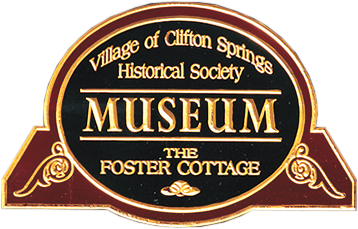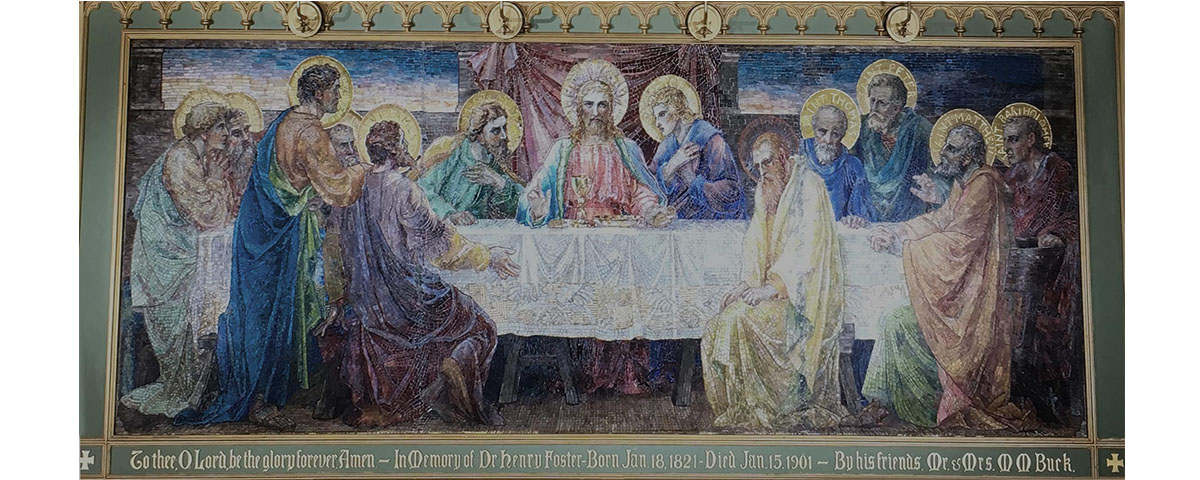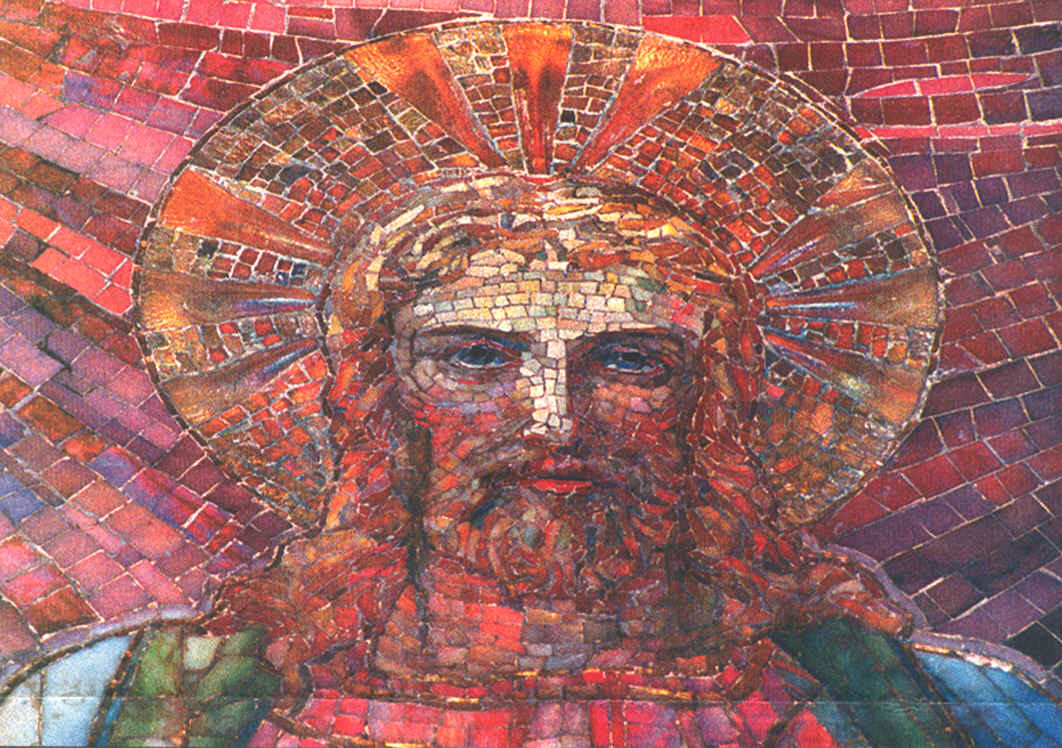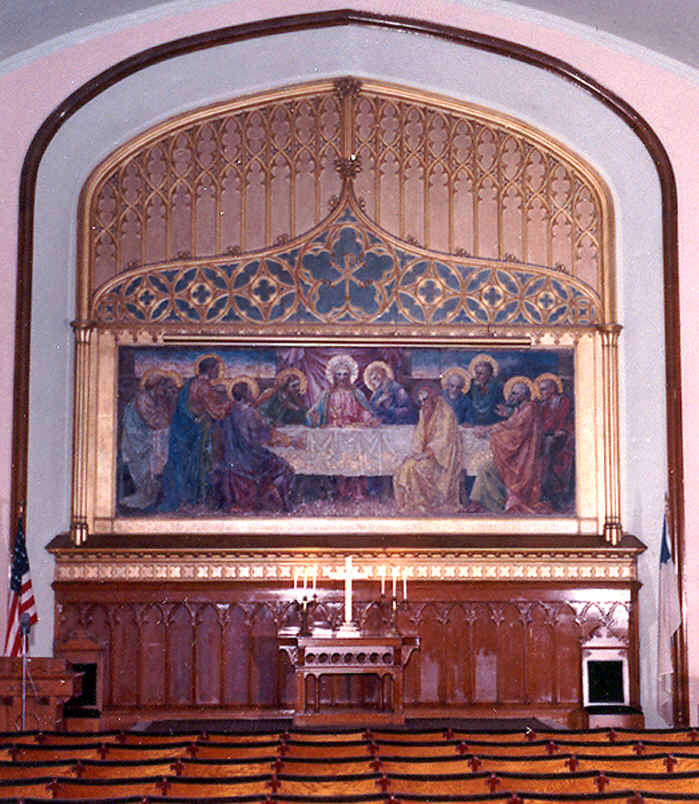'Christ and His Disciples'
No one can doubt that the real reason our village came into being was the founding by Dr. Henry Foster of his Water Cure here in 1850. Sure, many other
things could have brought about the founding of Clifton Springs, but first it was our Sulphur waters and the "good doctor" which gave us our start and helped make us what
we are today. It is difficult for us, not living in Dr. Foster's shadow, to realize the impact that he had upon so many people and over such a large part of this country.
Because of his efforts, his feelings, and most especially because of his outlook, many people throughout the world knew of Clifton Springs. During his lifetime he was not
just a doctor but also a friend to all who came to know him.
It was because of this man, that we can today claim to hold In trust one of the loveliest memorials anywhere in the world, Tiffany's mosaic and reredos of "The Last Supper".
Most of us when we hear the name Tiffany immediately think of that "extra special" jewelry store in the heart of Manhattan in New York City. Until I became more interested
in the history of this fine piece of art, I always connected the name in the same way. But the author of this "fravile" glass mosaic was not Charles Lewis Tiffany, the
founder of the jewelry business, but his son, Louis Comfort Tiffany who is responsible for the mosaic we see hanging in the chapel of the Sanitarium Apartments Building.
(Our old sanitarium)
Louis was brought up with no worry as to where money would come from. As one today would say, "he was born with a silver spoon in his mouth", and that was no pun on words.
His father, Charles, by the time Louis was born in February of 1848, was a wealthy man. Louis as a young man took a great interest in art of all kinds and traveled in
Europe and painted in watercolor and oil. He was a pupil of the artist, George Inness, and studied with Samuel Coleman. He early became interested in the development
of glass and the many colors and types of glass that could be made. I suppose the artist heart in him sought out a new art form or a new way of making the production
of glass an art in itself. By 1875 he had established his first glass factory and was making vases, cigarette boxes, and tiles for walls and floors.
During these years, Louis kept in touch with his many artist friends and not only visited all of the major exhibitions throughout the world, but began to display some
of his" glassworks." By the year 1893 he had developed a type of glass which he called "favrile" glass, which was iridescent glass with rich colors from deep blue to
purple and from green to yellow-gold. Some of these were made by carving through one layer of glass to that of another color. The surface of the glass had a silky
appearance. By 1894, Louis had registered the name "favrile" as a trademark. The word was derived from the old English word, fabrile, meaning, "belonging to the craft."
We do not have any official record as to what year the mosaic was made, but one day we will. It may have been displayed at the 1900 Exposition Universelle in Paris for
Tiffany did exhibit his favrile vases and some windows there. Louis may well have had some input into the completion of this mosaic of the Last Supper, and it certainly
came from the Tiffany studio and was worked on by his artisans.
Leonardo Da Vinci did the original painting, of the Last Supper, but the rendition we have is a copy of the painting done by the American artist, Frederic Wilson, which
is a more gentle, quiet version of Christ and his disciples. The Tiffany studios were responsible for many church windows and mosaics, and there does not seem to be
today a complete listing of them all. It would be interesting to see the original sketches and know who and when it was first worked on.
We are again fortunate to have a copy of the Clifton Springs Press article on the installation of the mosaic here. It seems, that shortly after the death of Dr. Foster,
Mr. & Mrs. Myron Buck, who were summer residents from St. Louis, MO and close friends of Dr. Foster, were in New York City. They stopped in the Tiffany Studios to see
if they could find something as a fitting memorial to the doctor. They were shown sketches of the Last Supper, then on display at the Pan‑American Exposition in Buffalo,
NY in the summer of 1901. They made a special trip there to view the mosaic and finding it to be "something very special", it was purchased. It was not until that fall
that representatives from Tiffany's arrived at Clifton Springs to visit the chapel and make arrangements for its installation. It makes no mention in the article just
how the mosaic arrived here, but if I had to guess, I would imagine it came by train.
The mosaic was of favrile glass, which gave the effect of strong color without light passing through the pieces themselves. It is six feet high by sixteen feet long
and cast in cement. Tiffany described the glass as usually iridescent, like the wings of certain American butterflies, the neck of pigeons or peacocks or like
the wing-covers of some beetles. Whatever the process by which the hot glass when cast, it gives forth a very special warmth and glow to all who see it. The
mosaic is set-off by another Tiffany art, that of the wood that surrounds the painting, known as a REREDOS! I was at a loss to know what the word meant, but
sure enough, it is right there in the dictionary. A reredos is "an ornamental wood or stone screen or partition wall behind an altar." This "framing" is a piece
of art in itself and well worth your viewing when you visit our MASTERPIECE. It is a celebration in wood and surrounds our special copy of " The Last Supper".
Myron Buck was a native of nearby Shortsville and ended up a man of great wealth, due to his enterprise in railroad supplies, which was centered in St. Louis.
The ill health of Mrs. Buck brought the couple here in 1875 where Mrs. Buck made an excellent recovery. Dr. Foster and the Bucks became close friends and the
Bucks purchased a summer home on East Main Street in Clifton Springs to which they returned in each summer. It is because of the nature and work of our Dr.
Foster that this memorial was given in his name. Near the mosaic are the words, "To thee, 0 Lord, be the Glory, Forever. Amen." In memory of Dr. Henry Foster,
Born Jan. 18, 1821 ~ Died Jan. 15, 1901, by his friends, Mr. & Mrs. M. M. Buck.
Our TREASURE is still as beautiful as the day it was installed. May it long remain in our midst and may we continue to use this lovely chapel in which it is
displayed. This was the center of Dr. Foster's institution, a center for his prayers and those of his staff. We will never know all the MIRACLES that have been
performed here, but we can gaze on this splendid work and know that there is still much strength in the "wee small voice" that speaks to our hearts when we look
at this lovely work of art!
By Frederick L. Gifford
Village Historian Emeritus



